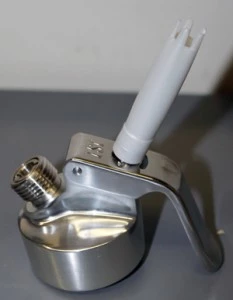We’ve had a good amount of questions recently about our dispenser parts. So we wanted to dedicate a blog about the parts of the whippers. It’s a common problem that you loose your parts in the whipper, to either the garbage disposal or any other instance. The good news is we have some! You can find them here. It’s always good to go back to the basics to understand the elements of your whipper and terminology. For example purposes, we are going to use a ISI Profi whipper, which is one of ISI’s top of the line whippers with a stainless steel canister(the same one that Starbucks uses). This whipper is a push lever whipper, you might be familiar with there Desert Whip or Mini whip series which is the same design. Lets first go to the basics and label each part.
Head of the whipped cream dispenser – Inside the head is the Head Valve and Gasket
the tips screw on to the top of the head valve. (as pictured)
The whipped cream only becomes a solid or foam when you press the lever, a mm of the head valve becomes exposed inside. The canister is under pressure because of the N20 and quickly pushes out with the whipping cream through the head valve.
N20 is extremely soluble in fatty compounds, it is dissolved in the fatty cream until it leaves the canister, when it becomes gaseous and then creates foam” whipped cream”. The whipping cream must have a minimum fat content of 28% to produce whipped cream with a dispenser. A whipped cream dispenser needs to be shaken after the N2O is inserted so that the N2O can bind with the fats in the cream. Then while pressurized within the canister the N2O remains bound within the fat. Once the cream is depressurized via the nozzle and the N2O expands within the fat molecule. Which makes whipped cream four times the volume of the liquid, whereas whipping air into cream only produces twice the volume. Carbon dioxide cannot be used for whipped cream because it is acidic in water, which curdles the cream and gives it a seltzer-like taste.
It’s very important after each batch of whipped cream you finish or between uses( IE: breakfast- dinner) that you clean out your dispenser. If your using it between use, unscrew the tip and clean it out with sudsy warm water, and the cleaning brush that came with your dispenser – if you can’t find it, you can buy them from or parts page, or use a pipe cleaner like brush. We recommend after each batch you take your whipped cream canister apart, take out the gasket, and head valve and clean it with sudsy warm water. It’s important to make sure there is no cream particles lodged inside the head valve, or any where in the dispenser. Make sure to dry it thoroughly after use, either air drying or with a dish towel. Aluminum does not rust, but it does corrode, so make sure your dispenser is taken care of properly.
“when I dispense the N20 in the canister it shoots out the top of the nozzle”
“When I dispense the N20 in the canister it comes out where the canister and the head meet”
This is a question we get a lot. If the N20 is escaping from the nozzle, it means the head valve is bad and you need a new head valve, this is the only solution. Make sure not to tamper with your head valve, unless you are cleaning it, this will limit issues.
If your gas is escaping where the canister and head meet, then most likely it is your gasket that needs replacing. Check your gasket and make sure it’s there of course, and there are no lacerations that would cause it to leak.
If you ever have any questions or concerns about your whipper, don’t hesitate to call us. As the saying goes “there are no dumb questions, only dumb answers” and we’ll do our best to limit those! We usually can remedy the problem quickly and get you back on the whipped cream express.

